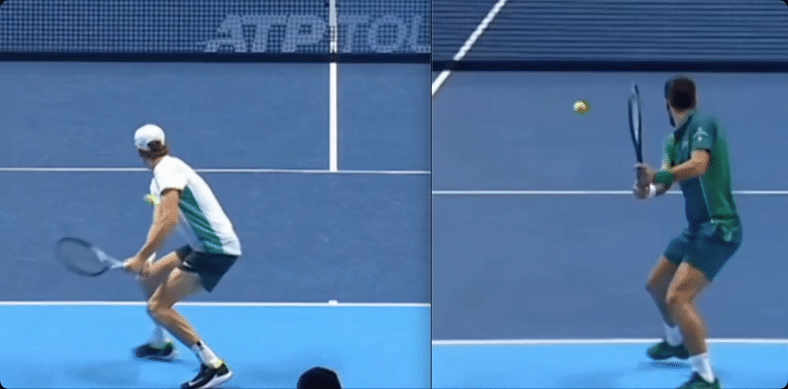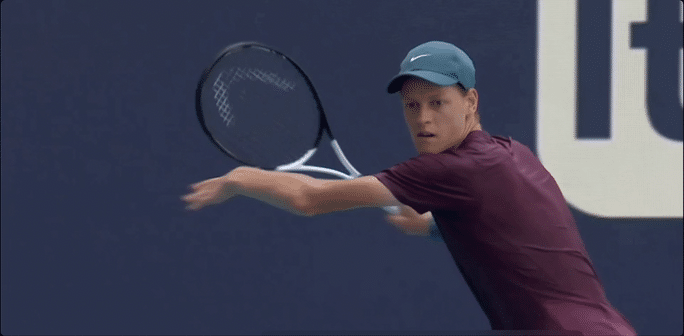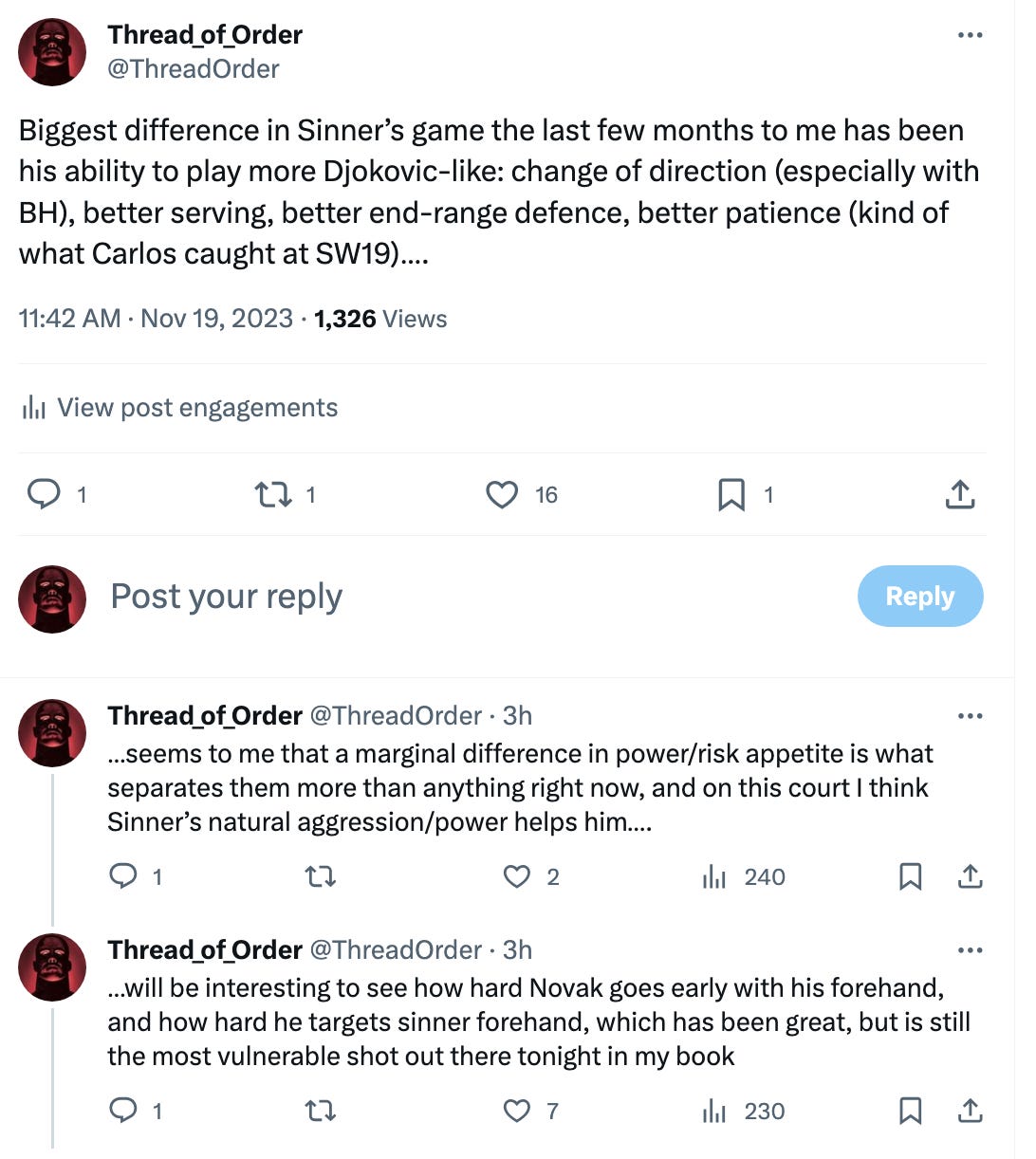Novak Djokovic exacted revenge on his round-robin loss to Jannik Sinner earlier in the week, defeating the young Italian 6/3 6/3 on Sunday to claim a record-breaking seventh ATP Tour Finals title.
As I tweeted before the match, Sinner’s biggest improvements throughout the latter stages of the season have mirrored much of what Djokovic does so well. Greater shot tolerance, increased consistency in rally-ball change-of-direction, and a clear uptick in serve potency have resulted in landmark wins over Medvedev (x3 after being 0-6 in their H2H) in recent weeks, as well as Djokovic (after being 0-3), and Rune (0-2 prior) in the group stage of the tournament this week.
All these improvements were on display in Sinner’s win over Djokovic five days ago. Djokovic let Sinner dictate too much from the baseline in that match, and given a chance at redemption on a quick indoor court, an uptick in aggression was expected from the Serb in Sunday’s final.
It didn’t take long to get our answer: the intent was clear from the opening game that Djokovic wasn’t going to sit back hoping Sinner would miss. Instead, the Serb looked to keep Sinner off-balance with his unmatched change of direction:

And it wasn’t just shot placement that showcased Novak’s intent. After four games he was absolutely humming the forehand:

And yet, it wasn’t the Serb who was bleeding errors despite his increased risk appetite. Sinner’s forehand, as has been the case in most of their prior matches, was the weak link in the baseline exchanges once again. Djokovic’s ability to target that shot relentlessly with both his forehand crosscourt and backhand down-the-line meant there was no reprieve; there was no safe side for Sinner to play to. Go to Djokovic’s forehand and he’s crushing them back crosscourt near 140km/h. Go to Djokovic’s backhand and he’s stinging you up the line with fading lasers.
As I’ve written previously, technique dictates tactics. Djokovic’s backhand setup position promotes timing and accuracy. There is little to undo as he starts to accelerate.1 Sinner’s backhand setup, with closed strings outside the line of his hands, uses a large ‘dynamic flip’ that generates a lot of racquet head speed (and subsequent spin and power) but it can’t time the ball as well, especially when changing direction. While Sinner has showcased an improved willingness and execution to go line with his backhand, Djokovic is the king at changing direction (in part) because his technique makes that easier for him compared to Sinner. A look at their differing takebacks and initial forward swings:

But the backswing is not the only point of difference. Their follow-throughs also highlight why Djokovic is so good at hitting lasers in both directions:

Ironically, it seems to always be Djokovic who actually plays offense when he takes on big hitters by virtue of his ability to control the ball into areas of the court that are uncomfortable for his opponent. He hit more forehand winners than Tsitsipas in Australia, dominated Alcaraz in the forehand battle at Roland Garros, and destroyed Sinner off both wings here tonight.
“Sinner just can’t get on balance during these points. There’s never been a player [Djokovic] better at changing direction off both forehand and backhand. Sinner is just constantly moving; he’s never set and able to get the big hit in.”
—TennisTV
Djokovic broke in Sinner’s second service game courtesy of a 168km/h forehand winner, a deft backhand lob, and three Sinner forehand errors.2 From there the set was basically over considering that Djokovic was hitting an ace or unreturnable on more than 50% of his serves. The accuracy was phenomenal:
Set 1 rap sheet:

Djokovic didn’t let up at the start of the second, putting Sinner through some side-to-side pain at 0-15 and 0-40 until the Italian cracked with more forehand and backhand errors. The distance Sinner had to cover with the repeated line balls from Djokovic just killed his legs, along with any chance of playing attack. This is exactly the kind of tennis Djokovic’s greatness rests upon, and it’s exactly the kind of tennis that gets commentators and fans thinking Djokovic’s opponent didn’t play well. They can’t play well. No one can play well when you get dragged line to line. From a previous piece:
Corner defence married with controlled depth and subtle change-of-direction may not make for good highlight reels, but it allows him [Djokovic] to effortlessly tear apart top-20 opposition.

The same swing mechanics that are evident in their backhands are also found in their forehands. Similar to the recent Paris final runner-up (Dimitrov), Sinner takes his forehand back lower to the side and is more compact, but requires a large dynamic flip to accelerate. Djokovic has a higher and longer takeback that takes more time to prepare but has less to undo into contact. This kind of trend was the reason I started writing the newsletter with ‘Death of a Forehand’. I am yet to see a modern-day forehand with those pieces stack up to the Djokovic version and in big matches over the past year or so it has repeatedly been a style of shot that seems vulnerable.

And while Sinner’s indoor campaign has been brilliant and friendly to his style, this match was yet another data point that echoes Davydenko’s sentiment from last year (emphasis added):
“In my opinion, tennis is not making much progress. The players who are at the top now – not Nadal and Djokovic, but the younger generation –are not that good technically. I got surprised by that. It’s more physical – big serves, hitting hard–, but we still see that Nadal and Djokovic can control all this power over the new generation. They are still winning Slams and beating guys who are ten years younger than them, which is amazing. Anyway, I do not feel that the new generation is playing on an unbelievable level.”
—Nikolay Davydenko for Clay Tennis
I think Sinner (and his younger rivals Alcaraz and Rune) have shown patches of brilliance throughout the year. Of course, Alcaraz at Wimbledon was a bonafide brilliant match that revealed he was a special player and capable of playing with control and patience, but none have been able to match Djokovic’s sustained level across the year.
I don’t believe the difference between these top young players and someone like Djokovic is something divine or entirely explained by experience or superior mentality. In fact, we’ve seen how fallible Djokovic is when parts of his game waver from good technique. Holger Rune’s ex-coach, Lars Christensen, echoed Davydenko’s thoughts:
“If there are limits in those two things [balance and technique] they are going reach a certain level and they’re just going to plateau. It’s not going to be possible to take them any further.”
By my count, I had Sinner with three times as many errors on the forehand wing for the same number of winners (4).
Djokovic from the ATP website (emphasis added):
“It’s one of the best seasons I’ve had in my life, no doubt," Djokovic said at the close of a 55-6 campaign. "To crown it with a win against a hometown hero in Jannik, who has played amazing tennis this week, is phenomenal. I’m very proud of the performances these past two days against Alcaraz and Sinner, probably the best two players in the world next to me and Medvedev at the moment — and the way they have been playing, I had to step it up.
“I had to win the matches and not wait for them to hand me the victory and that’s what I’ve done. I think I played different tactically than I did in the group stage against Jannik, and just overall it was a phenomenal week.”
After last year’s ATP Final between Ruud and Djokovic, I signed off with a reminder of this newsletter’s inspiration. I feel it is fitting to leave it here again after today’s match:
While good technique is not an automatic panacea that will take a player to the top (movement, athleticism, desire, mental strength, and good tactics are all necessary) poor technique will undoubtedly leave players exposed despite their best efforts, as I have touched on repeatedly over the course of the year. A reminder of the newsletter’s inspiration from the first post:
“The man who believes that the secrets of the world are forever hidden lives in mystery and fear. Superstition will drag him down. The rain will erode the deeds of his life. But that man who sets himself the task of singling out the thread of order from the tapestry will by the decision alone have taken charge of the world and it is only by such taking charge that he will effect a way to dictate the terms of his own fate.”
— Cormac McCarthy, Blood Meridian
Great performance has a signal, and the very best are willing to change and adapt to meet the technical and tactical landmarks that reality rewards.
A final note: We now have over 2000 subscribers and are marching toward 2500! I must sound like a broken record with all this merry-go-round and Ferris Wheel chat week after week, but Djokovic’s dominance has forced my hand. However, I do have plans to expand the scope of ‘A Thread of Order’ to include more long-form topical pieces (one will drop soon), more draw previews, podcast episodes, mailbags, and more. If you have suggestions write a comment below, and if someone else’s suggestion piques your own interest, give it a like as well. Over the course of the next six months I will be finishing my Masters in sports psychology, where I am interviewing professional tennis coaches about their experiences on the ATP tour, but will endeavor to still maintain pieces at the current clip I’ve been going at. Following this I will have more time to dedicate to the newsletter. If you feel this newsletter is adding some value, a share or subscription is always appreciated.
See you in the comments. HC
Zverev has similar mechanics.
The reported speeds from the ATP’s Infosys match statistics don’t seem accurate (with a couple of Djokovic forehand winners reportedly 198km/h and 204km/h)…. But whatever.









https://photos.app.goo.gl/aHhU7LRjti1YJDdF7
I'd like to see content on how recreational players can incorporate this technical philosophy into their game. There's a lot of content about tips, tricks and cues for the strokes, but there's not a lot about how to actually deliberately practice to incorporate them into your game.